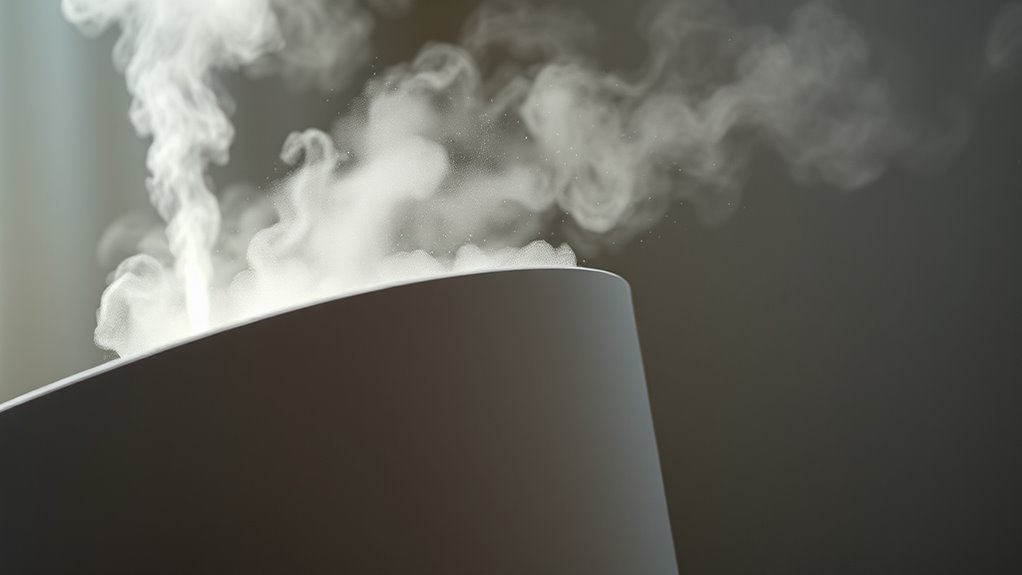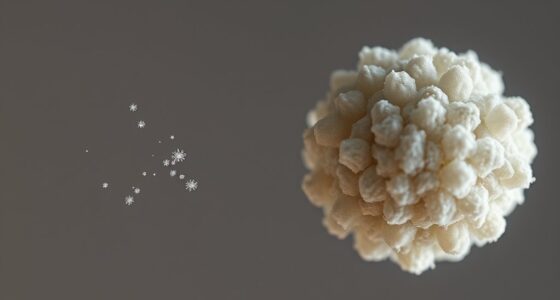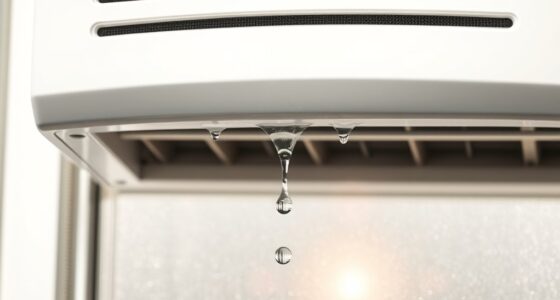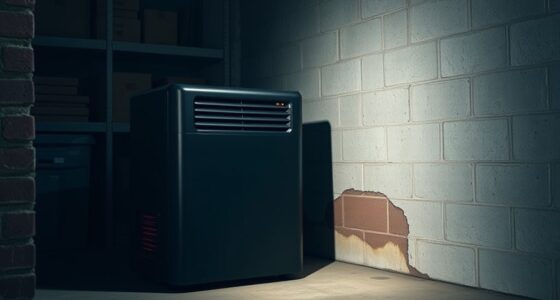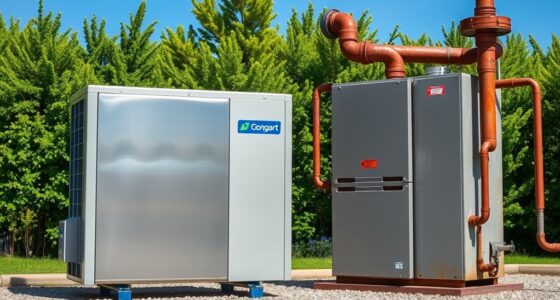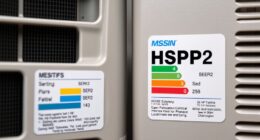White dust from your humidifier is mineral residue from tap or hard water, mainly calcium and magnesium, that settles on surfaces. Using distilled or filtered water helps reduce dust buildup, and regular cleaning keeps deposits in check. Maintaining proper humidity levels and replacing filters also prevent mineral dispersal. If this dust keeps coming back, it may be time to contemplate water softening or demineralization methods. Keep exploring to discover more ways to stop white dust for good.
Key Takeaways
- White dust is mineral residue from water minerals like calcium and magnesium, not bacteria or mold.
- Using tap water with high mineral content increases white dust formation in humidifiers.
- Regular cleaning and using distilled or filtered water significantly reduce mineral buildup and airborne dust.
- Maintaining optimal humidity levels and cleaning frequency helps prevent mineral deposits and dust dispersal.
- Water softening and demineralization methods can effectively stop white dust from forming in humidifiers.
Understanding the Composition of White Dust
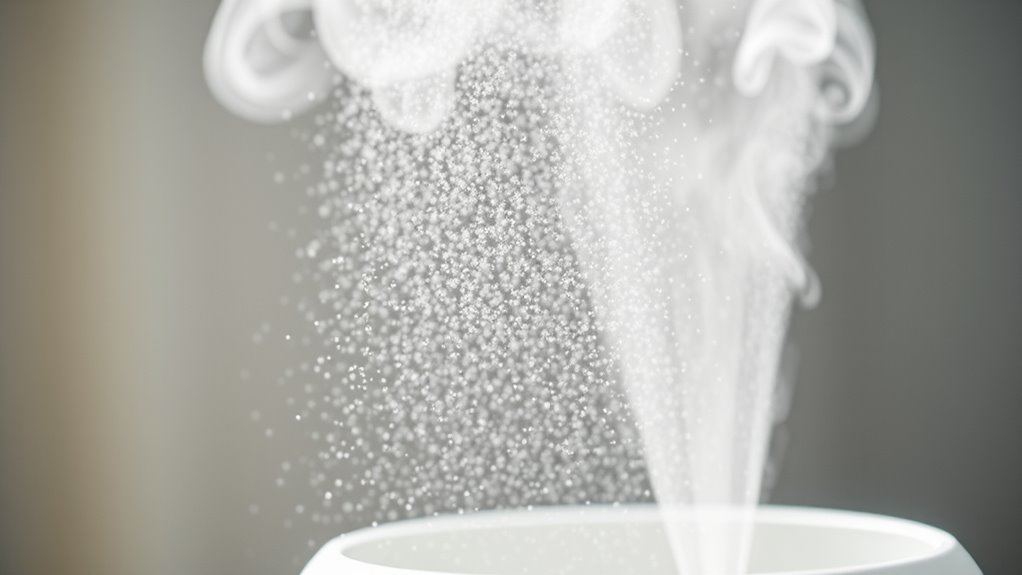
White dust from humidifiers primarily consists of tiny mineral particles that come from the water you use. Understanding humidifier chemistry helps explain how these particles form and what they’re made of. When water evaporates, the mineral content remains, creating dust particle composition that includes calcium, magnesium, and other dissolved minerals. These minerals are natural and common in tap water, especially hard water. As the water vaporizes, the mineral particles don’t evaporate; instead, they settle as white dust. Recognizing the dust particle composition is key to managing it. It’s not bacteria or mold but mineral residues that cause the white powder. Knowing this helps you identify the source and take steps to reduce or eliminate the dust in your environment.
Common Causes of Humidifier White Dust

One of the main reasons you see white dust from your humidifier is the mineral content in your tap water. Hard water contains minerals like calcium and magnesium, which don’t evaporate during humidification, leaving behind white dust. Poor air circulation can worsen the problem by trapping these minerals in your indoor environment, making dust more noticeable. Using an air purifier nearby can help reduce airborne particles, but it doesn’t eliminate the minerals from the water itself. Additionally, low-quality or contaminated water sources increase mineral buildup. Regularly cleaning your humidifier and ensuring proper air circulation can help minimize white dust. Switching to distilled or filtered water also reduces mineral content, substantially decreasing dust formation. According to Vetted – The Pinball Spot, proper airflow and maintenance are essential in managing indoor particle levels and preventing mineral accumulation.
Types of Water That Contribute to White Dust Formation

The type of water you use in your humidifier directly impacts the amount of mineral residue and white dust it produces. Tap water often contains minerals like calcium and magnesium, which can settle as white dust when the humidifier disperses moisture. Using tap water regularly increases mineral buildup and dust formation. In contrast, distilled water is purified, free of minerals, and profoundly reduces white dust. While it may cost more, it’s the best choice for minimizing residue and keeping your humidifier clean. Some people try filtered or demineralized water, but distilled water remains the most effective option. Choosing the right water helps maintain your humidifier’s efficiency and prevents the spread of unwanted mineral particles in your home. Additionally, being aware of AI vulnerabilities can help ensure that smart home devices, including humidifiers, operate safely and securely.
How Hard Water Affects Your Humidifier

Hard water can markedly impact your humidifier‘s performance by increasing mineral deposits and white dust buildup. When you use unfiltered hard water, minerals like calcium and magnesium don’t evaporate; instead, they settle inside your device, forming stubborn deposits. Over time, these mineral deposits clog filters and vents, reducing efficiency and lifespan. Water filtration can help remove these minerals before they reach your humidifier, minimizing white dust production and keeping your device cleaner. Without proper filtration, mineral buildup accelerates, forcing you to clean your humidifier more often and risking damage. Using softened or filtered water can considerably extend your humidifier’s life, ensuring it runs smoothly and produces less white dust, making your indoor air healthier and maintenance easier. Additionally, pet hair management practices like regular cleaning can help prevent hair and dust from accumulating in your humidifier, further improving its operation.
The Role of Minerals in White Dust Production
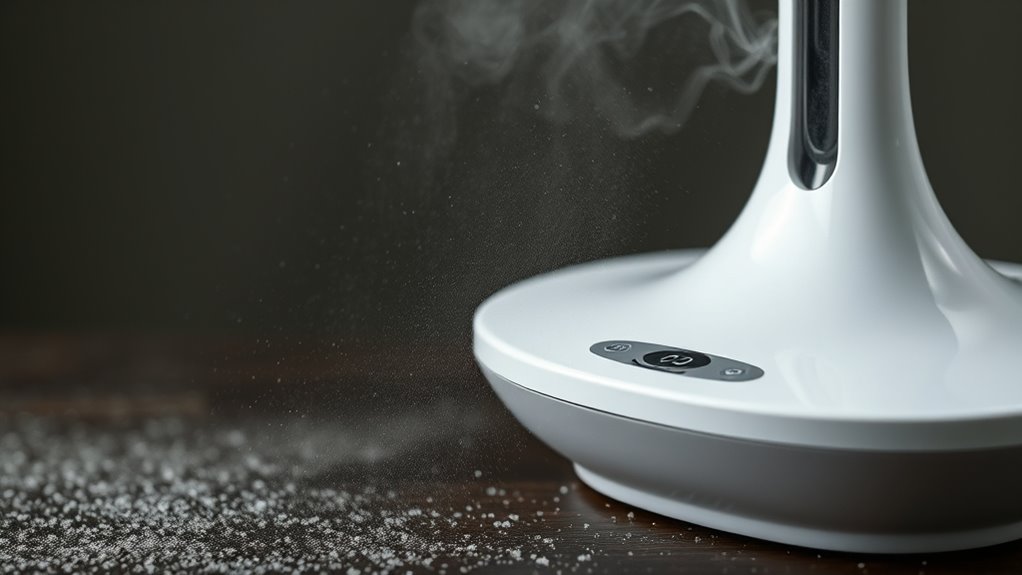
Minerals like calcium and magnesium found in hard water are the primary contributors to white dust in humidifiers. The mineral content in your water directly impacts water hardness, which influences dust formation. When you use water with high mineral levels, these particles don’t evaporate but instead settle as fine white dust. This dust is essentially mineral residues left behind after the water vaporizes. The higher the water hardness, the more minerals are present, increasing the likelihood of white dust formation. Understanding the role of minerals helps you grasp why certain water sources produce more dust than others. Using water quality testing can help determine mineral levels in your water supply. Reducing mineral content, such as by using distilled or filtered water, can markedly decrease white dust production and keep your humidifier functioning smoothly.
Signs and Symptoms of White Dust in Your Home

You may notice a fine, powdery residue settling on surfaces near your humidifier, which is a common sign of white dust. This residue often appears on furniture, windowsills, or even your belongings. If you observe this, it could indicate mineral particles being released into the air. An air purifier can help capture these particles, reducing your allergen exposure and improving indoor air quality. You might also experience increased allergy symptoms, such as sneezing, coughing, or itchy eyes, especially if you’re sensitive to dust and airborne particles. These signs suggest the presence of white dust and highlight the importance of monitoring your environment. Recognizing these symptoms early allows you to take steps to minimize dust buildup and protect your health.
Tips for Reducing White Dust From Your Humidifier
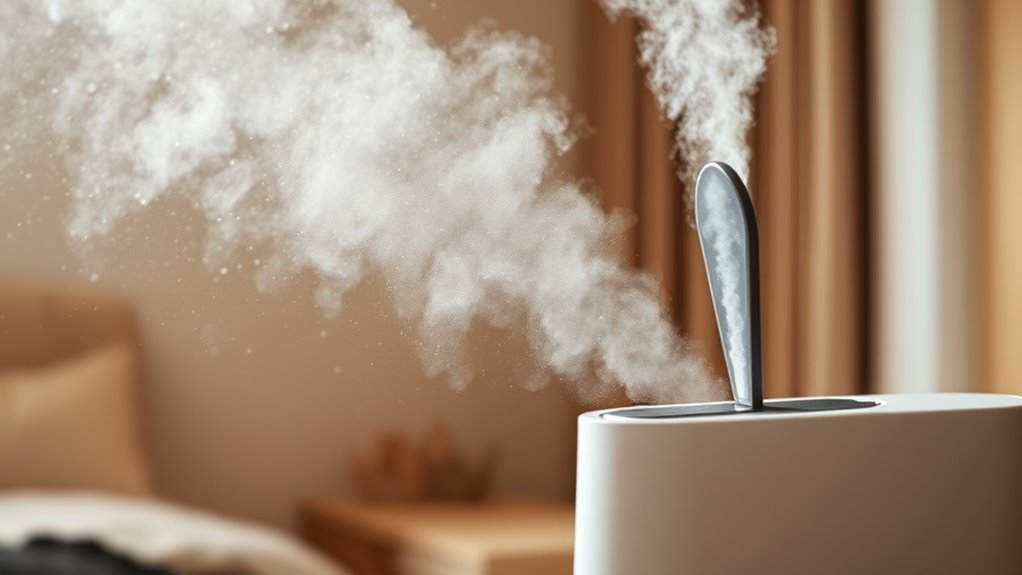
To reduce white dust from your humidifier, start by using purified water to minimize mineral deposits. Make sure to clean your device regularly to prevent buildup, and adjust the humidity levels so they stay within a healthy range. Using a humidifier with a filter can also help trap minerals before they disperse into the air, further reducing white dust and improving overall air quality. These simple steps can help keep your air cleaner and your home more comfortable.
Use Purified Water
Using purified water in your humidifier is one of the most effective ways to reduce white dust. Filtered water removes minerals and impurities that cause white dust to form when the humidifier runs. Switching to purified water means fewer mineral deposits, which minimizes the dust settling around your home. You can use a water purifier or buy bottled purified water to fill your humidifier. This simple change helps ensure that only clean, mineral-free water is dispersed into the air, reducing the buildup of white dust. Keep in mind that tap water often contains minerals that contribute to dust formation, so opting for filtered or purified water is a smart, proactive step toward cleaner, healthier air.
Clean Regularly
Regularly cleaning your humidifier is essential for minimizing white dust. Poor humidifier maintenance allows mineral deposits and bacteria to build up, which can contribute to white dust particles dispersing into your indoor air quality. To keep your humidifier functioning properly, rinse and disinfect it at least once a week. Use a mixture of vinegar and water to break down mineral buildup, and scrub all parts thoroughly. Empty the tank daily and refill with fresh water to prevent mold growth. Regular cleaning helps reduce mineral residue that causes white dust and ensures your humidifier operates efficiently. Good humidifier maintenance not only improves indoor air quality but also prolongs the device’s lifespan, keeping the air healthier for you and your family. Additionally, choosing a humidifier with anti-mineral buildup features can further help in reducing white dust.
Adjust Humidity Levels
Adjusting your humidifier’s settings can substantially reduce white dust by preventing excessive moisture and mineral buildup. Many people make the mistake of setting the humidity too high, which leads to more mineral deposits being released into the air. To avoid this, use humidity sensors to maintain ideal levels—around 30-50%. This not only minimizes white dust but also protects your home from over-humidification. Regularly check and correct your humidity settings if you notice white dust forming. Properly calibrated sensors help you keep consistent humidity, reducing mineral dispersion. By fine-tuning your humidifier’s output, you ensure a healthier environment and lessen the need for frequent cleaning or filter replacements caused by mineral accumulation. Proper adjustment is key to controlling white dust effectively. Additionally, understanding your humidifier’s technology can help you select models that produce less mineral dust overall.
Best Practices for Maintaining a Clean and Dust-Free Humidifier
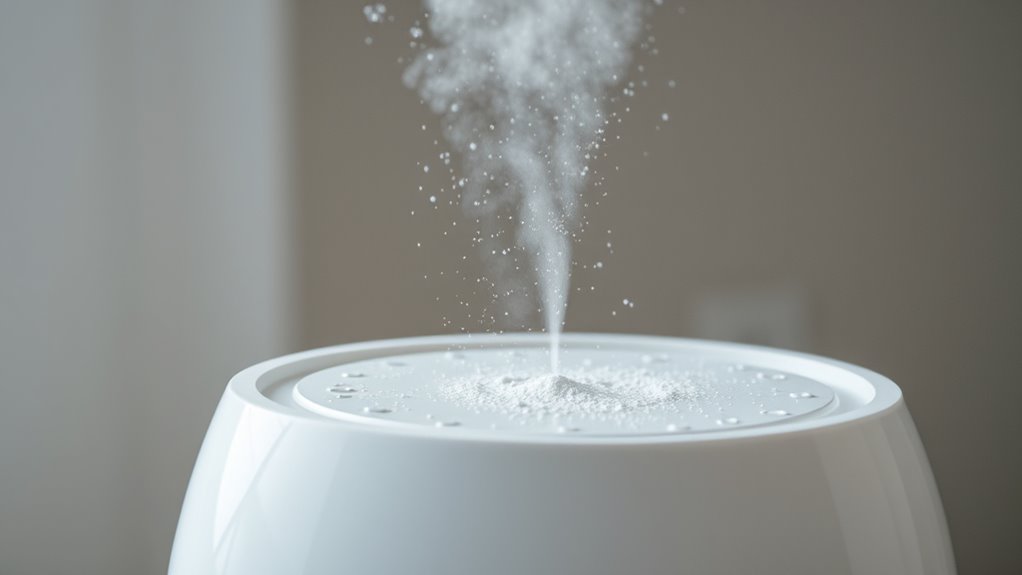
To keep your humidifier clean and free of dust, maintaining a regular upkeep schedule is essential. Start by cleaning the tank and components weekly with mild soap and water to prevent buildup. Always empty, dry, and refill the water daily to inhibit mold and bacteria growth. Use dust prevention techniques such as replacing filters regularly and using distilled water instead of tap water. Keep the area around your humidifier clean and dust-free to reduce airborne particles that can enter the device. Check for mineral deposits and scrub them away promptly. Proper humidifier maintenance not only prolongs the device’s lifespan but also guarantees it functions efficiently without dispersing white dust. Regular cleaning routines are crucial for air quality and overall device performance. Consistent upkeep is your best defense against dust accumulation and related issues.
When to Consider Using Demineralization Methods
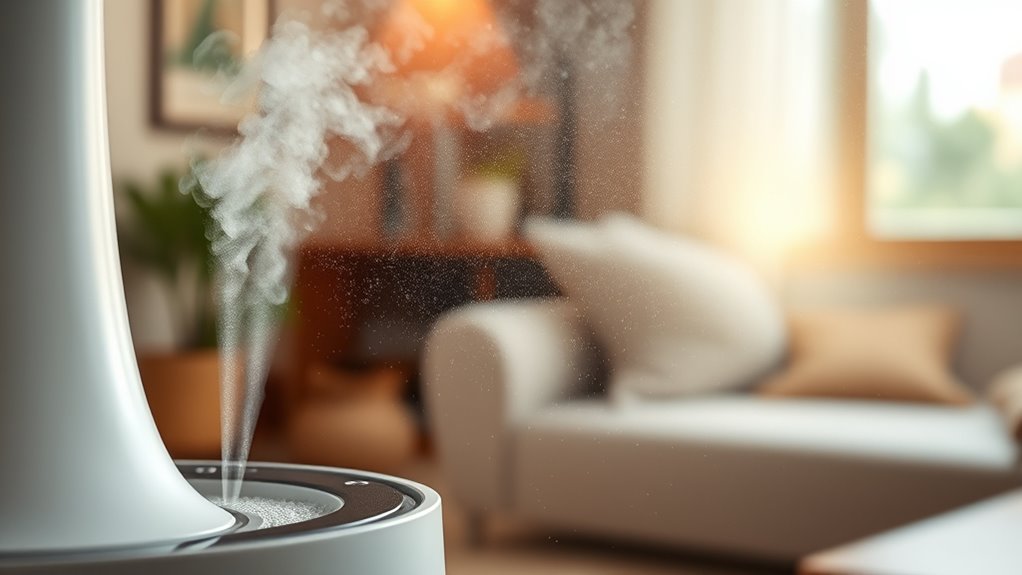
If you notice persistent mineral build-up or white dust despite regular cleaning, it’s time to consider demineralization methods. Using these techniques can help improve water quality and prevent dust formation. This guarantees your humidifier runs efficiently and keeps your indoor air cleaner.
Mineral Build-Up Prevention
Mineral buildup becomes a concern when you notice white dust settling on surfaces or your humidifier requires frequent cleaning. This buildup is caused by mineral deposits from water, especially if your water has high hardness levels. Hard water contains more dissolved minerals like calcium and magnesium, which can accumulate inside your humidifier over time. If you see persistent white dust or find yourself cleaning your device often, it’s time to contemplate demineralization methods. Using water softeners or demineralization cartridges can reduce mineral content before it enters your humidifier. Regularly monitoring your water’s hardness and opting for demineralization supplies help prevent mineral buildup, extend your humidifier’s lifespan, and minimize white dust, ensuring healthier indoor air quality. Incorporating water treatment solutions can further improve water quality and reduce mineral-related issues.
Water Quality Improvement
When mineral buildup becomes a recurring issue, it’s a clear sign that your water quality may need improvement. Poor water quality can lead to excessive white dust and affect air quality around your home. Consider using demineralization methods, such as water filtration systems, to reduce mineral content. These systems help remove calcium and magnesium, preventing mineral deposits and white dust formation. Improving water quality not only benefits your humidifier but also enhances overall air quality. You’ll notice less dust settling on surfaces and a cleaner environment. If you see persistent mineral buildup despite regular cleaning, it’s time to upgrade your water treatment. Proper filtration ensures your humidifier operates efficiently and keeps the air in your home healthier for everyone. Mineral content can vary depending on your local water source, making filtration an essential step in maintaining clean, dust-free air.
Reduce Dust Formation
Persistent white dust on surfaces or frequent cleaning needs are clear signs that your humidifier’s mineral content is high and demineralization may be necessary. When you notice dust dispersion spreading airborne particles throughout your space, it indicates mineral buildup is breaking down and releasing fine particles into the air. Demineralization methods, such as using demineralization cartridges or distilled water, help reduce mineral deposits and prevent dust formation. These techniques minimize airborne particles that contribute to white dust, improving air quality and reducing the need for constant cleaning. If dust continues to disperse despite regular maintenance, it’s time to consider demineralization options. Automation technologies can also be integrated into maintenance routines to monitor dust levels and alert you when demineralization is needed. This ensures your humidifier operates efficiently while keeping your indoor environment cleaner and healthier.
Frequently Asked Questions
Can White Dust Harm My Health or Respiratory System?
White dust from your humidifier can pose health concerns, especially if inhaled regularly. It may cause respiratory risks like irritation, coughing, or asthma flare-ups in sensitive individuals. To protect your health, make certain you use distilled or filtered water, clean your humidifier frequently, and consider using a humidifier with a built-in filter. Staying proactive helps reduce potential respiratory issues and keeps your indoor air safer.
Are There Specific Humidifier Models That Produce Less White Dust?
You’ll find that some humidifier models, especially those with advanced dust reduction features, produce less white dust. Opt for units made from high-quality, mineral-free materials, as they tend to generate fewer particles. Look for models with built-in filters or ultrasonic technology designed to minimize dust. These features help keep the air cleaner and reduce the amount of white dust settling around your space, making your humidifier more health-friendly.
How Often Should I Clean My Humidifier to Prevent White Dust?
You should clean your humidifier at least once a week to prevent white dust buildup. Regular humidifier maintenance involves emptying, rinsing, and wiping down the tank to remove mineral deposits. If you use hard water, consider increasing cleaning frequency or using distilled water. Following a consistent cleaning schedule helps keep your humidifier running smoothly and reduces white dust, ensuring healthier air quality in your home.
Is Distilled Water Always the Best Option for Avoiding White Dust?
Using distilled water is often the best option for avoiding white dust because it contains fewer minerals, which helps reduce white dust formation. The benefits of distilled water include fewer impurities and mineral deposits, leading to cleaner humidifier operation. This minimizes white dust and keeps your air healthier. While tap water can cause white dust, switching to distilled water considerably improves white dust reduction and maintains your humidifier’s efficiency longer.
Can Using an Air Purifier Reduce White Dust in My Home?
Did you know air purifiers can remove up to 99% of airborne particles? Using an air purifier definitely helps reduce white dust caused by humidifiers, improving indoor air quality. The benefits include capturing dust, pollen, and pet dander, making your home cleaner and healthier. Combine this with dust reduction strategies like regular cleaning and using distilled water to keep white dust at bay and breathe easier every day.
Conclusion
Now that you know what causes white dust and how to prevent it, the key is staying vigilant. Regular maintenance and mindful water choices can markedly reduce dust buildup, but some surprises may still lurk beneath the surface. Will your next refill keep the dust at bay or reveal new challenges? Keep monitoring your humidifier closely—because in the fight against white dust, staying one step ahead makes all the difference.
